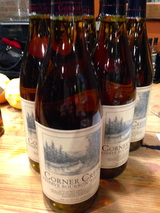 My New Year's whiskey tasting challenge went social this weekend at an event at Brooklyn Wine Exchange: Bourbon vs Rye. While I had tasted many of the classics offered, I did get to meet two new bourbons. Meeting whiskey at a party with a bunch of people is not quite the same as meeting it alone at a bar. I didn’t catch everything it was trying to say. But whatever, we had fun and I learned other useful things. For instance, Kyle Devine – who was leading the class – gave us a helpful way to think about the general flavors in rye and bourbon. He described it like bread – corn bread is sweeter; rye bread is spicier. Which sounds obvious, but hadn’t occurred to me before. When I think of it that way, other flavors from those breads pop out in my mind to try and taste in the whiskies. I see an afternoon of pairing whiskies and breads in my future. But for now, let’s meet J.W. Overbey Bourbon and Corner Creek Bourbon. These two show the range of bourbon production in the US. J. W. Overbey is made in Bed-Stuy, Brooklyn. It’s so local that Joseph (as in J) stopped by our class to pour some out for us. It ages four to six months in small (5-gallon) barrels, and they make about five barrels per month, which, as Joseph pointed out, “is pretty good for a 600-square-foot distillery.” They use traditional methods that people used for making bourbon on farms 100 years ago.  Corner Creek is bottled by Kentucky Bourbon Distillers, Ltd., which is a large operation in Bardstown, Kentucky that produces a variety of ryes and bourbons, including the Willett ones. Tough to say how much of Corner Creek is produced, but KBD is the kind of place with warehouses aging thousands of barrels at a time. This one is aged for 8 years. J.W. Overbey Bourbon: What we knew: 70% corn, 30% barley, 90 proof. What I learned: I may have been slightly swayed on the Overbey because of Joseph himself. He was kind of quirky and enthusiastic to share all about how bourbon is made. He also focuses on using local grains – an emphasis by quite a few local distilleries. It definitely tastes young but not harsh. It has its own, soft flavor that is not super sweet. I don’t know that I had a full conversation with this whiskey, but I had enough of a conversation that I want to learn more. So I will need a second date with this one. Corner Creek Bourbon: What we knew: A wheated bourbon with a little rye, 88 proof. What I learned: This one surprised me. Another wheated bourbon, W.L. Weller, is my “house bourbon” when I can find it (damn those bourbon shortages), and that’s got a nice soft sweetness to it. Corner Creek had a fairly sweet nose but was much spicier on the tongue and had a bit of a band-aid taste to it with some pepper thrown in. It did soften as I drank it and it left an aftertaste of the idea of syrup, but I don’t know that the flavor combination was my favorite. I think second date is denied on this one. The other whiskies at the party were all old friends – Four Roses Single Barrel, Rittenhouse Rye, and Smooth Amber Old Scout Rye – so they don’t count toward my New Year’s challenge. I will say I would hang out with them any time.
2 Comments
Billy Destro
1/11/2015 02:41:15 pm
In the spirit of trying different mashbills (and bread), I heard a lot of good reviews about Parker's Heritage Wheat Whiskey. Maybe you could get a date with it for this month's 33 in 30? It might be difficult tracking some down though because it's one of those "allocated" whiskys.
Reply
Whiskey Goddess
1/12/2015 09:38:00 am
Thanks for the suggestion! It was a good one. Stay tuned...
Reply
Your comment will be posted after it is approved.
Leave a Reply. |
Archives
November 2017
|

 RSS Feed
RSS Feed
